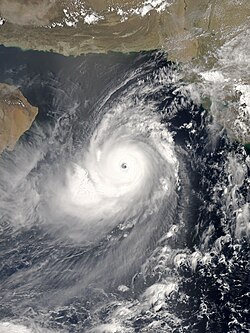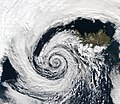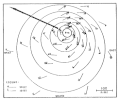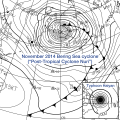Portal:Tropical cyclones
The Tropical Cyclones Portal

A tropical cyclone is a storm system characterized by a large low-pressure center, a closed low-level circulation and a spiral arrangement of numerous thunderstorms that produce strong winds and heavy rainfall. Tropical cyclones feed on the heat released when moist air rises, resulting in condensation of water vapor contained in the moist air. They are fueled by a different heat mechanism than other cyclonic windstorms such as Nor'easters, European windstorms and polar lows, leading to their classification as "warm core" storm systems. Most tropical cyclones originate in the doldrums, approximately ten degrees from the Equator.
The term "tropical" refers to both the geographic origin of these systems, which form almost exclusively in tropical regions of the globe, as well as to their formation in maritime tropical air masses. The term "cyclone" refers to such storms' cyclonic nature, with anticlockwise rotation in the Northern Hemisphere and clockwise rotation in the Southern Hemisphere. Depending on its location and intensity, a tropical cyclone may be referred to by names such as "hurricane", "typhoon", "tropical storm", "cyclonic storm", "tropical depression" or simply "cyclone".
Types of cyclone: 1. A "Typhoon" is a tropical cyclone located in the North-west Pacific Ocean which has the most cyclonic activity and storms occur year-round. 2. A "Hurricane" is also a tropical cyclone located at the North Atlantic Ocean or North-east Pacific Ocean which have an average storm activity and storms typically form between May 15 and November 30. 3. A "Cyclone" is a tropical cyclone that occurs in the South Pacific and Indian Oceans.
Selected named cyclone -
Super Cyclonic Storm Gonu was an extremely powerful tropical cyclone that became the strongest cyclone on record in the Arabian Sea. The second named tropical cyclone of the 2007 North Indian Ocean cyclone season, Gonu developed from a persistent area of convection in the eastern Arabian Sea on June 1, 2007. With a favorable upper-level environment and warm sea surface temperatures, it rapidly intensified to attain peak winds of 240 km/h (150 mph) on June 4, according to the India Meteorological Department. Gonu weakened after encountering dry air and cooler waters, and early on June 6, it made landfall on the easternmost tip of Oman, becoming the strongest tropical cyclone to hit the Arabian Peninsula. It then turned northward into the Gulf of Oman, and dissipated on June 7, after making landfall in southern Iran, the first landfall in the country since 1898.
Intense tropical cyclones like Gonu are extremely rare in the Arabian Sea, and most storms in this area tend to be small and dissipate quickly. The cyclone caused 50 deaths and about $4.2 billion in damage (2007 USD) in Oman, where the cyclone was considered the nation's worst natural disaster. Gonu dropped heavy rainfall near the eastern coastline, reaching up to 610 mm (24 inches), which caused flooding and heavy damage. In Iran, the cyclone caused 28 deaths and $216 million in damage (2007 USD). (Full article...)
Selected article -
The effects of Hurricane Georges in Louisiana included $30.1 million in damage and three deaths. Forming from a tropical wave over the Atlantic Ocean, Georges attained a peak intensity of 155 mph (249 km/h) on September 20, 1998. Over the following several days, the storm tracked through the Greater Antilles and later entered the Gulf of Mexico on September 28, the Category 2 storm made landfall in Mississippi before dissipating on October 1. Before landfall, about 500,000 residents in Louisiana evacuated from low-lying areas. The mayor of New Orleans declared a state of emergency to allow federal assistance into the state. After nearly 1.5 million people were urged to evacuate coastal areas, officials described the evacuation as "probably the largest [...] we have ever achieved".
Numerous homes located outside the levee system were flooded by the storm surge, and 85 fishing camps on the banks of Lake Pontchartrain were destroyed. An estimated 160,000 residences were left without power due to Georges and severe beach erosion took place due to the slow movement of the hurricane. Precipitation statewide peaked at 2.98 inches (76 mm) in Bogalusa, and wind gusts reached 82 mph (132 km/h). In the wake of the hurricane, the Federal Emergency Management Agency (FEMA) opened 67 shelters throughout the state, and covered insurance claims totalling $14,150,532, including from Puerto Rico and Mississippi. The Clinton administration appropriated $56 million in disaster relief to regions in Louisiana for recovery from Tropical Storm Frances and Hurricane Georges. (Full article...)
Selected image -

Selected season -

The 2013 North Indian Ocean cyclone season was an above average and deadly season. The season had no official bounds, but cyclones typically formed between May and December, with the peak from October to November. These dates conventionally delimit the period of each year when most tropical cyclones form in the northern Indian Ocean.
The scope of this article is limited to the Indian Ocean in the Northern Hemisphere, east of the Horn of Africa and west of the Malay Peninsula. There are two main seas in the North Indian Ocean — the Arabian Sea to the west of the Indian subcontinent, abbreviated ARB by the India Meteorological Department (IMD); and the Bay of Bengal to the east, abbreviated BOB by the IMD. (Full article...)
Related portals
Currently active tropical cyclones
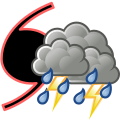
Italicized basins are unofficial.
- North Atlantic (2025)
- No active systems
- East and Central Pacific (2025)
- No active systems
- West Pacific (2025)
- No active systems
- North Indian Ocean (2025)
- No active systems
- Mediterranean (2024–25)
- No active systems
- South-West Indian Ocean (2024–25)
- No active systems
- Australian region (2024–25)
- No active systems
- South Pacific (2024–25)
- No active systems
- South Atlantic (2024–25)
- No active systems
Last updated: 22:55, 20 June 2025 (UTC)
Tropical cyclone anniversaries
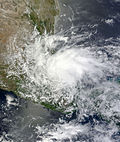
June 20,
- 2009 - Tropical Storm Linfa reaches peak intensity as a severe tropical storm. Linfa caused damages of about $105 million, mostly from eastern China and Taiwan.
- 2013 - Tropical Storm Barry (pictured) makes landfall over in Veracruz, Mexico, killing only five people in total.

June 21
- 1989 - Hurricane Cosme made landfall over in southern Mexico as a category 1 hurricane killing a total of 30 people.
- 2008 - Typhoon Fengshen (pictured) reached its peak intensity of 200 km/h (125 mph) while moving through the Philippines. Fengshen killed more than 1,300 people mostly from the capsizing of the MV Princess of the Stars.

June 22,
- 1972 - Hurricane Agnes made landfall near New York City. Agnes killed 129 people and caused over $2 billion of damage throughout the eastern United States, with the worst of the damage in the states of Pennsylvania and New York.
- 2015 - Tropical Storm Kujira (pictured) reaches tropical storm intensity before making landfall in southern China. Kujira killed nine people and damaged ¥88 million (US$14.4 million).
Did you know…




- …that the Joint Typhoon Warning Center considers that Typhoon Vera (pictured) of 1986 is actually two distinct systems, formed from two separated low-level circulations?
- …that Cyclone Freddy (track pictured) in 2023 was the longest-lasting tropical cyclone recorded?
- …that the typhoons of 2024—Yinxing, Toraji, Usagi, and Man-yi (pictured)—made history as the first recorded instance since 1951 of four tropical cyclones coexisting in November?
- …that Hurricane Otis (pictured) in 2023 was the first Pacific hurricane to make landfall at Category 5 intensity and surpassed Hurricane Patricia as the strongest landfalling Pacific hurricane on record?
General images -

The 2007 Pacific hurricane season was an event in the annual cycle of tropical cyclone formation. This timeline documents all the storm formations, strengthening, weakening, landfalls, extratropical transitions, and dissipation. The timeline also includes information which was not operationally released, which is information from post-storm analysis by the National Hurricane Center.
The season officially started on May 15, 2007, in the eastern Pacific, designated as the area east of 140°W, and on June 1, 2007, in the central Pacific, which is between the International Date Line and 140°W, and lasted until November 30, 2007. These dates conventionally delimit the period of each year when most tropical cyclones form in the Pacific basin. The season began slowly; through the end of July, the seasonal Accumulated Cyclone Energy (ACE) was the third lowest since the geostationary satellite era began in the 1966 Pacific hurricane season. The inactivity continued through the next month, which was the third quietest August in terms of ACE since reliable records began in the basin during the 1971 Pacific hurricane season. In June, Tropical Storm Barbara caused $55 million (2007 USD) in crop damage to southeastern Mexico from heavy precipitation. In August, Hurricane Flossie formed in the eastern Pacific and crossed into the central Pacific; the hurricane threatened Hawaii but caused little damage. In early September, Hurricane Henriette dropped heavy rainfall in southwest Mexico, which caused nine fatalities and $25 million (2007 USD) in damage. (Full article...)
Topics
Subcategories
Related WikiProjects
WikiProject Tropical cyclones is the central point of coordination for Wikipedia's coverage of tropical cyclones. Feel free to help!
WikiProject Weather is the main center point of coordination for Wikipedia's coverage of meteorology in general, and the parent project of WikiProject Tropical cyclones. Three other branches of WikiProject Weather in particular share significant overlaps with WikiProject Tropical cyclones:
- The Non-tropical storms task force coordinates most of Wikipedia's coverage on extratropical cyclones, which tropical cyclones often transition into near the end of their lifespan.
- The Floods task force takes on the scope of flooding events all over the world, with rainfall from tropical cyclones a significant factor in many of them.
- WikiProject Severe weather documents the effects of extreme weather such as tornadoes, which landfalling tropical cyclones can produce.
Things you can do
 |
Here are some tasks awaiting attention:
|
Wikimedia
The following Wikimedia Foundation sister projects provide more on this subject:
-
Commons
Free media repository -
Wikibooks
Free textbooks and manuals -
Wikidata
Free knowledge base -
Wikinews
Free-content news -
Wikiquote
Collection of quotations -
Wikisource
Free-content library -
Wikiversity
Free learning tools -
Wikivoyage
Free travel guide -
Wiktionary
Dictionary and thesaurus

